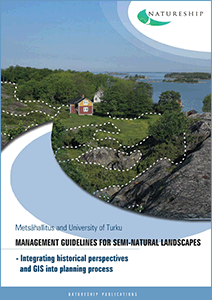Management guidelines for semi-natural landscapes – Integrating historical perspectives and GIS into planning process
This publication has been produced as a part of the Natureship project (2009-2013) coordinated and partly financed by the Centre for Economic Development, Transport and the Environment (CEDTE) for Southwest Finland. Natureship project is an international project including members from Estonia, Finland and Sweden.
This publication concentrates on the management approaches and planning principles for semi-natural landscapes in the nature conservation network. It tries to establish improved solution for management planning of diverse natural and cultural values. We present practical methods for the integration of landscape history with biological knowledge, via the use of various materials. Geographical information Systems (GIS) and use of spatial data originating from multiple sources are one of the primary tools we have used in this process. We show how knowledge of past human activities leads to better understanding of the current values in semi-natural landscapes. With improved understanding of history and landscape dynamics, natural and cultural heritage can be bound together and considered in mutual management planning processes.
Our work is based on four case studies from Archipelago National Park, which is a good example of diverse and multi-valued landscape in south-western Finland. The park hosts the highest species diversity in Finland, tightly bound to both cultural and natural values and diverse habitats and landscapes. At the same time it contains well-preserved examples of cultural heritage and contains numerous traces of past activities.
